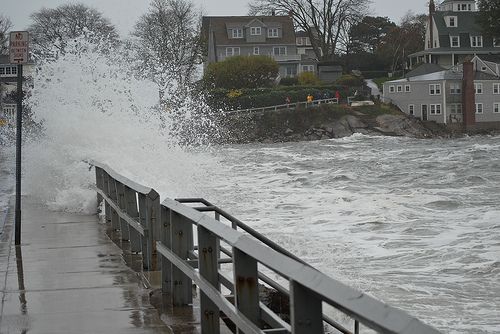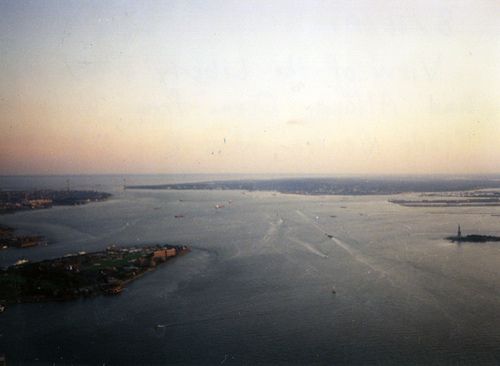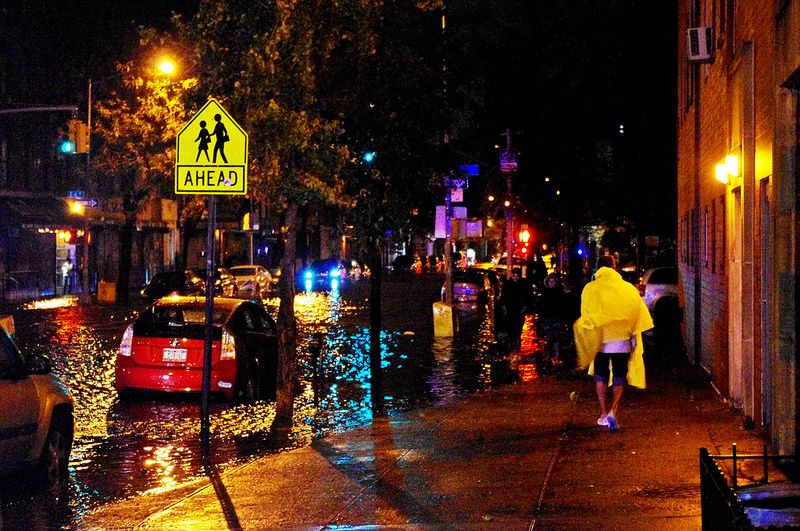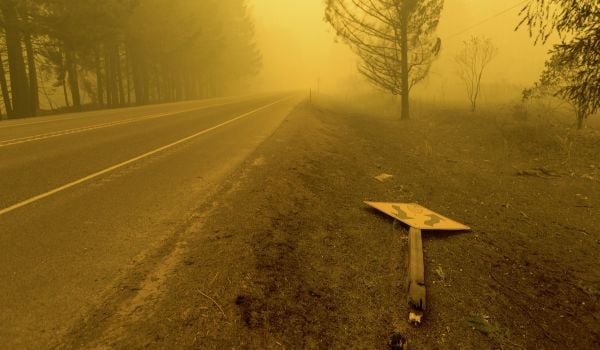Hurricane Sandy has everyone from commenters of Twitter to the governor of New York talking about ways to potentially seal off New York Harbor from rising floodwaters. And when, in the United States, you want to undertake a major civil works project, the builders are generally the U.S. Army Corps of Engineers. They’re the ones with the expertise, budget and national scope required by that sort of undertaking.
But as the Army Corps is pointing out now, the vision has to come from somewhere else.
“State and local officials would need to request federal support for a project, such as a levee or other approaches, which would then need congressional authorization and appropriation,” writes Army Corps public affairs officer Pete Pierce in an email. The USACE has 400 people on the ground in the New York region undertaking “unwatering” and other efforts, including the 249th Engineer Battalion dedicated to setting up emergency power supplies. But, writes Pierce, “It would be inappropriate at this time for USACE to speculate about future projects in New York.”
With talk of New York City levees in the air after Hurricane Sandy, what’s becoming clear is that the possibility of large-scale storm water protections is a political, even social question, as well as an engineering one, with the possibility of 100-year storms having to reconcile with political cycles that churn in two and four year blocks.
For his part, New York Gov. Andrew Cuomo has floated the possibility of levees or some other storm surge protections, according to the New York Times. After Hurricane Irene and now Sandy, said Cuomo, the time has probably arrived for the water-surrounded city to consider some sort of large-scale prophylactic.
But Cuomo is finding himself a bit at odds with Mayor Michael Bloomberg. At a press conference Thursday, Bloomberg batted away the talk of levees. “I don’t know that I think there’s any practical ways to build barriers in the oceans,” he said. “When you have an enormous harbor like we do and Long Island Sound, even if you spend a fortune, it isn’t clear to me that you would get much value for it.”
Instead, Bloomberg focused on more granular techniques for addressing a city that floods. “It’d be great,” he said, for example, “if you didn’t put your generators in the basement.”

A Sandy storm surge in Massachusetts. Credit: Brian Birke on Flickr
A look at the science of storm surge protection suggests that Bloomberg, despite his own engineering background, is perhaps not all that well versed in the work that has been done in the field. Robert G. Bea is an engineer with a deep background in storm water protections and a professor emeritus at the University of California at Berkeley (as well as an Army Corps of Engineers vet). Asked if, indeed, it’s technological possible to protect New York City through some sort of levee system, Bea responds without hesitation.
“The answer is, for sure, yes.” Bea points to the Dutch Delta Works system of dams, dikes and levees that has been much in the news of late. “They sit on the same damn ocean that you do,” he says. (I’m in Brooklyn.) “That Atlantic is a real damn kick-in-the-bum piece of water.”
One plan being floated is for a system made up of a pair of storm barriers, one stretching from Sandy Hook, N.J. to the Rockaways, in Queens — about a five-mile gap — and the other a half-mile barrier crossing the Long Island Sound somewhere in the vicinity of the Throgs Neck or Queens-Whitestone Bridge. The Sound, say engineers, acts much like a funnel, making surges there potentially even more worrisome.
Malcolm J. Bowman, a professor of physical oceanography who leads SUNY Stony Brook’s Storm Surge Research Group, describes the envisioned storm surge barriers as “big gates that swing one like saloon doors,” with proper levees running from them to the water’s edge. (Here’s a schematic of the New York Harbor proposal.)
Bowman says he isn’t surprised that Bloomberg right now doesn’t want to entertain the possibility of inserting a physical barrier between his city and future Hurricane Sandy-type storms. “It’s a bit hard to discuss draining the swamp when you’re up to your ass in alligators,” the oceanographer syas.
But the engineers argue that the cost-benefit analysis of storm barriers around New York City tips the scales toward their construction. “The factor of paying for it later,” says Bea, “is 100 to 1000 times the amount it would have cost if you had addressed it earlier.” The price tag on the the proposed saloon gates around New York City is challenging to come by, but one hears figures in the millions; loss of life aside, the cost for Hurricane Sandy’s destruction is being counted in billions.
What’s needed, says Bowman, is a regional if not national response, something like the Thames River Barrier, or St. Petersburg’s series of damns, or the Dutch example. “The city can’t do it alone,” he says.

New York Habor. Credit: Flickr user InSapphoWeTrust
Worth noting: Mitt Romney has been criticized in the context of Hurricane Sandy for disapproving of the current funding levels for FEMA, which generally focuses on post-disaster relief, saying that states (and better yet, the private sector) should take over emergency response where they’re capable of doing so. Obama’s 2013 budget would cut FEMA funding by 3 percent, and the proposed budget of Romney running mate Paul Ryan could cut it by an estimated 40 percent.
The Netherlands’ historic water stopping project was constructed amid fits and starts and controversy after a 1953 flood killed more than 1,800 Dutch people. The country’s very existing requires protecting against the sea and, says Bea, one of the major advances was aligning their political imperatives with the threat at hand. “Their attention was riveted on getting it right,” he says. “If they didn’t they’ve have had to learn German.”
“They had to reengineer their governmental structure to face their environmental challenge,” he says, pointing to the political focus on their Rijkswaterstaat, or department of public works.
Similarly, says Bea, “New York City’s challenge is a national challenge.”
At the moment, the Army Corps of Engineers is kicking things over to state and local officials. Getting something done would require the vocal advocacy of public officials. Right now, at least, Cuomo is entertaining the idea of massive top-down storm protections, while Bloomberg is steering the conversation toward reactive techniques: Moving generators upstairs, figuring out how to storm-proof subway entrances. New York senators Chuck Schumer and Kirsten Gillibrand haven’t yet responded to a request for comment, but both have vocally advocated for increased Army Corps involvement in the New York area, such as the dredging of the Fire Island Inlet.
(The corps isn’t without its own problems. It has been much criticized over the years for everything from sub-standard work to its roles in Hurricane Katrina’s levees and the draining and then refilling of the Florida Everglades.)
To Bea, the UC-Berkeley storm protection expert, the trick is to not forget the challenge looming over New York City and the rest of the water-nested region as it moves forward. “Sitting in the middle of misery is a major opportunity,” says Bea. “The more blessed you are, the shorter term you think. We’re in more of a rush to return back to those blessings than we are to confront those longer-term threats. We’re actually fighting a human response to return to normalcy.”
But those looking to keep the focus on the New York region’s vulnerability to storms might have added fodder in the months ahead. The American Society of Civil Engineering, says Bowman, is working on putting together a book for next year on what it would take to protect New York from water.

Nancy Scola is a Washington, DC-based journalist whose work tends to focus on the intersections of technology, politics, and public policy. Shortly after returning from Havana she started as a tech reporter at POLITICO.
















